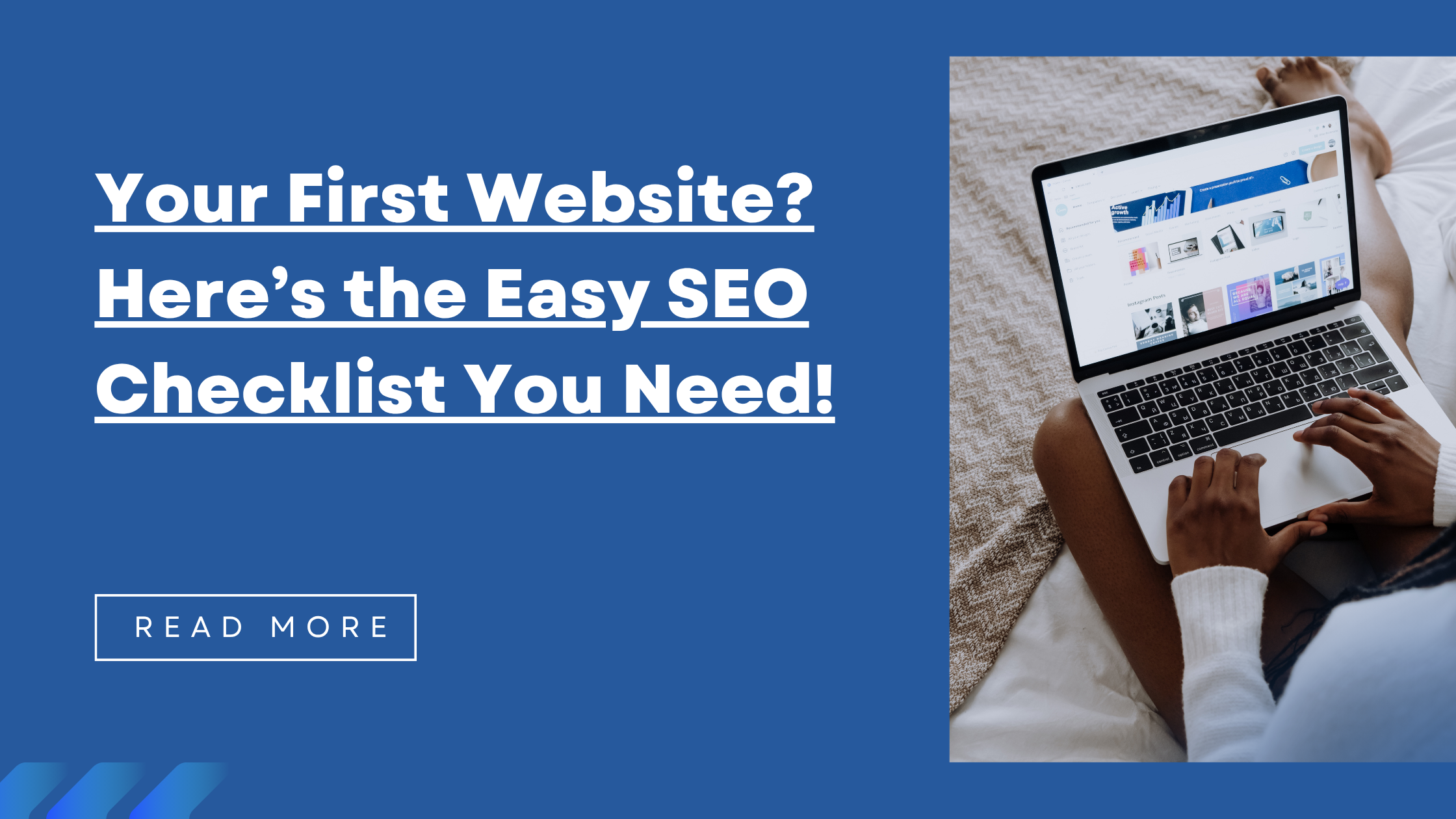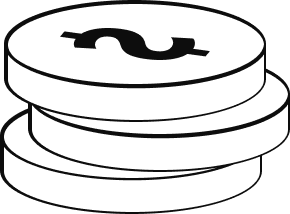Starting your own website is super exciting, right? You have picked a cool name, and written some awesome stuff, and now you are ready to show the world. But then someone mentions SEO, and suddenly it sounds confusing.
Don’t panic—it is easier than it looks. This guide exists to make on-page SEO as easy as possible to understand. By the end of it, you will know exactly what to do to get your website on Google.
Let’s get started!
What is SEO, Anyway?
SEO, or Search Engine Optimization, is the process of improving a website’s visibility on search engines like Google. The main goal of SEO is to help a website appear higher in search results when people search for related topics or keywords. This is important because most users tend to click on one of the top results, so better visibility can lead to more traffic and potential customers. SEO involves several strategies, including optimizing website content, improving page speed, using relevant keywords, and building high-quality backlinks. When done correctly, SEO can be a powerful tool for growing online presence and driving long-term success
Imagine your website as a new store. If you don’t have signs posted or arrange your merchandise, no one will be able to locate it! SEO is similar to posting signs, keeping your store tidy, and leading people to all the products.
In a broder term SEO is of 3 types
On-Page SEO
- Focuses on optimizing individual pages of a website.
- Includes keyword placement, content quality, meta tags, headers, and internal linking.
Technical SEO
- Involves improving the technical aspects of a website for better crawling and indexing.
- Includes site speed, mobile-friendliness, XML sitemaps, structured data, and security (HTTPS).
Off-Page SEO
- Refers to actions taken outside of your website to improve rankings.
- Primarily involves backlink building, social media signals, and online reputation.
Why Is On-Page SEO Important?
On-page SEO is important because it helps search engines understand what your website content is about and determines whether it’s relevant to a user’s search query. By optimizing elements like keywords, headings, meta tags, and internal links, you make it easier for search engines to index your pages correctly and rank them higher. This directly impacts your visibility in search results, which can lead to more organic traffic. Additionally, well-optimized pages offer a better user experience—through faster loading times, clear navigation, and high-quality content—which can reduce bounce rates and increase engagement. In short, on-page SEO lays the foundation for your site’s performance in search engines and plays a crucial role in driving meaningful traffic.
Your Simple On-Page SEO Checklist
Here’s your step-by-step guide. Just follow along one step at a time.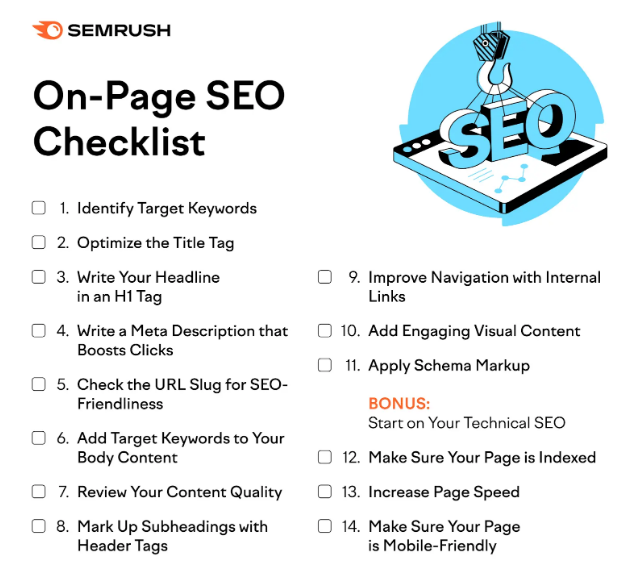
1. Find the Right Keywords (What Are People Searching For?)
Before you start writing, think: What would someone type into Google to find my website?
If you sell handmade jewelry, they might search for things like:
- handmade silver necklace
- unique earrings
- artisan jewelry
Here is How to Do It:
- Brainstorm: Make a list of keywords about your website.
- Use Google: Type words into Google and see what pops up in “People Also Ask” or “Related Searches.”
- Use long phrases: Like “handmade gold necklace with pearls” instead of just “necklace.”
- Pick one main keyword per page: This is the main thing each page is about.
To Do: Choose one main keyword for each important page on your site.
2. Write a Strong Page Title (Title Tag)
The title is what shows up on Google when people see your page. It is also the name that shows in the browser tab.
How to Make a Good Title:
- Put your main keyword at the beginning.
- Keep it short (around 60 characters).
- Make it interesting so people want to click.
- Add your website name at the end (optional).
Example:
Bad: Jewelry
Good: Handmade Silver Necklaces | Unique Designs – Sparkle Store
To Do: Check every page title and make sure it has your keyword and sounds nice.
3. Write a Catchy Meta Description
This is the short sentence that shows under your title in Google results. It does not help your ranking directly, but it helps people decide if they want to click.
Tips for Meta Descriptions:
- Say what your page is about.
- Use your main keyword naturally.
- Make it sound helpful or exciting.
- Keep it short (about 155 characters).
Example:
“Shop our handmade silver necklaces. Unique designs made with care. Find your perfect piece today!”
To Do: Write a short, helpful meta description for every main page.
4. Make Your URLs Simple and Clean
The URL is the web address of your page. A clear URL helps both people and search engines understand your page.
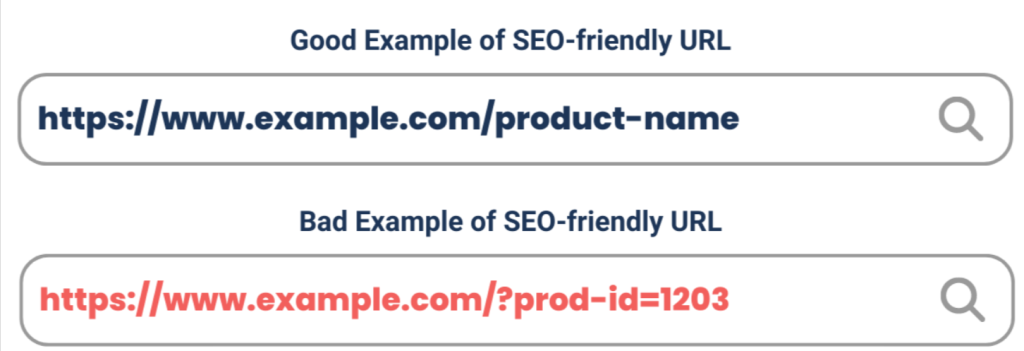
Good URL Tips:
- Include your main keyword.
- Use hyphens (not underscores or spaces).
- Keep it short and easy to read.
- No weird codes or numbers.
Example:
Bad: yourwebsite.com/page?id=123
Good: yourwebsite.com/handmade-necklaces
To Do: Check your page links (URLs) and make them simple.
5. Create Helpful, High-Quality Content
This is the most important part. Good content helps people stay on your site, learn something, and maybe even buy from you.
What Makes Content Good?
- It helps or answers a question.
- It’s clear and easy to read.
- It uses your keywords in a natural way.
- It’s not copied from someone else.
- It has headings, short paragraphs, and pictures.
To Do: Make sure every page has useful, original content that answers people’s questions.
6. Use Headings to Organize Your Writing
Headings help break up your content so it is easier to read. They also help Google understand your page.
How to Use Headings:
- H1 = Main title (only one per page, with your main keyword)
- H2 = Big sections
- H3 = Smaller sections under H2
To Do: Use headings to organize your content. Don’t just bold your text—use the real heading tags.
7. Add and Optimize Images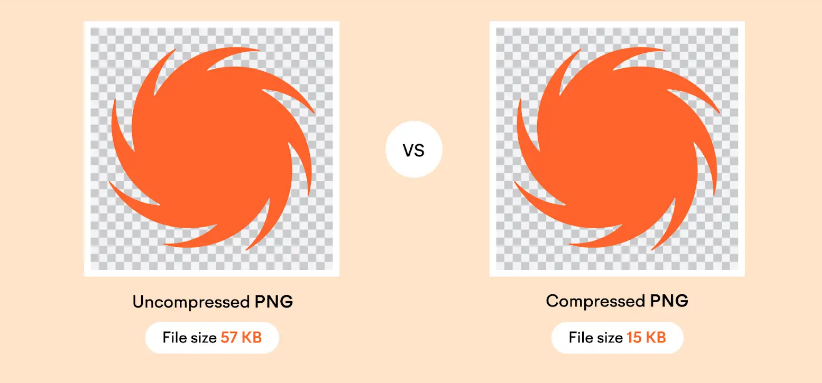
Pictures make your website look nice. But they can also help your SEO.
Here’s How to Optimize Them:
- Compress your images (smaller files = faster site).
- Use clear file names like handmade-necklace.jpg.
- Add alt text that describes the picture (this helps people who can’t see the image and helps Google too).
Example:
<img src=”handmade-necklace.jpg” alt=”Handmade silver necklace with turquoise stone”>
To Do: Add alt text and compress every image on your website.
8. Link to Other Pages on Your Website (Internal Links)
Linking between your own pages helps Google find and understand them. It also keeps visitors on your site longer.
Example:
Want to learn more about how we make our jewelry? Check out our behind-the-scenes page.
To Do: Link your pages together using helpful text (not just “click here”).
9. Link to Other Good Websites (External Links)
Sometimes it helps to link to other trusted websites. This shows Google that your site is helpful and well-researched.
To Do: Link to useful, trusted websites when it makes sense.
10. Make Sure Your Site Works on Phones (Mobile-Friendly)
Lots of people use phones to browse websites. Google likes sites that work well on all screen sizes.
How to Check:
- Visit your site on a phone. Does it look good?
- Use Google’s “Mobile-Friendly Test” tool to check.
To Do: Make sure your website looks and works great on phones and tablets.
11. Make Your Website Load Fast
Nobody likes a slow website. Google doesn’t either.
Speed Tips:
- Compress images (again!)
- Use a good website host
- Don’t use too many plugins or fancy effects
- Try Google’s PageSpeed Insights to get suggestions
To Do: Test your site speed and fix anything that’s slowing it down.
12. Use Schema Markup (Bonus Tip)
This one’s a little more advanced. Schema markup is a special code that helps Google understand your content better.
For example, if you post recipes, schema can tell Google the cooking time, ingredients, and more. This can help you show up with “fancy” search results like star ratings or extra info.
To Do: Once you have mastered the basics, learn about schema markup that fits your website.
Conclusion
Creating a new site is really fun, and if you spend a bit of time getting good on-page SEO from the start, you will be in the right place. SEO is not about how to manipulate Google. It’s actually about making your site useful and clear for both search engines and actual humans who come to your site.
Just stick to the checklist, do one thing at a time, and don’t be in a hurry. Keep improving your site, make it better and better gradually, and before long the right people will be finding you on the internet. Persevere, and you will achieve your objectives!

